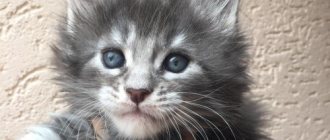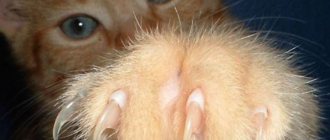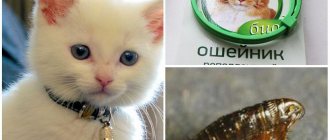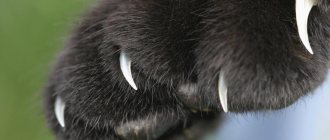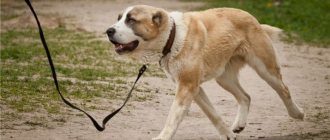Most felines grow to adult size by the time they reach puberty. Growth rates are influenced by many factors - breed, nutrition, functioning of the endocrine system, living conditions, etc.
Growth is usually understood as not only an increase in the size of the animal, but also the formation and formation of all organs and systems of the body. Veterinarians say that cats acquire unchanged features by the age of three, while cats, as a rule, do not change after two years.
The endocrine system, in particular the pituitary gland, which produces the hormone somatotropin, is responsible for regulating the increase in body size and the development of internal organs. A lag or even a complete stop in growth can also be caused by disturbances in the functioning of the thyroid gland, reproductive system, and adrenal glands.
How kittens grow into adult cats: stages of development
Before a baby kitten turns into an adult, a certain amount of time passes, which can be divided into separate stages. For each such segment of maturation, there are characteristic growth features.
Newborns: first week
Infancy, or the neonatal stage, does not last long. This period is only one week. At this time, newborns lose a little body weight. Weight loss is a norm that does not cause concern to a person.
Before weaning: 2-6 weeks
The breastfeeding, or suckling, stage lasts about 3.5 weeks. At this time, the cat-child begins to gain weight, grow and develop. It is necessary to provide access to the female's breast for weakened babies so that large and strong brothers do not take all the cat's milk.
Transition to independent living
The transitional stage often goes unnoticed by the owner. It lasts about 6 weeks and is characterized by slow development.
At this time, it is important to monitor the cat’s nutrition and start complementary feeding. He learns to go to the litter box, wash himself, eat and play on his own. But it’s too early for him to leave his home.
From 3 months to six months
Starting from 3 months, animals feed on their own, and now weight gain and full maturation completely depend on their diet. A balanced diet has a good effect on the formation of muscle and bone mass, organs and systems. It is at this time that maturation slows down a little.
Adolescence: from six months to the end of growth
The juvenile or teenage stage is considered the longest period. Veterinarians often define it from 3 months to full adulthood.
From the age of six months, the cat develops the features of an adult animal. After adolescence, females stop growing altogether, while males still grow by an average of 3 cm.
The nuances of growing up in the British and Scots
Representatives of the British and Scottish breeds are very popular among cat lovers today. British cats gain up to 6 kg, sterilized ones often reach 8 kg. Males usually weigh more. Unneutered pets reach eight kilograms. After castration, the animal can gain up to 9–10 kg.
Females stop growing at about one and a half years, males can gain weight up to 3 years. A three-year-old British cat is an adult, although a very young cat, but already at the age of eight months an individual of this breed is ready for mating.
For the Scots, the parameters of growing up are completely identical to those of the British. Fold and straight-eared Scottish cats stop growing at about one and a half years, males of this breed stop growing at 2.5–3 years.
What influences what age kittens grow to?
Normal maturation is influenced by heredity, breed, gender, time of weaning from the female, keeping the pet and its state of health.
Genetic predisposition
How long cats grow depends largely on the baby’s parents. It is quite rare for children to outperform their parents in terms of parameters. A large kitten from a small mother is extremely rare. Although this also happens.
Breed affiliation
Cats often differ in more than just the color or length of their fur. So, large cats always mature slowly and for a long time. And in small and medium-sized breeds the process goes a little faster.
Britons, Bengals and Maine Coons reach accepted standards by 2 or 3 years of age. Small cats - Singapuras, munchkins and some others - acquire their usual size at 12 months, their relatives of medium breeds - by 1.5 years.
Gender
During the first 6-12 weeks, both sexes develop equally. Later the processes change. Males begin to gain weight faster than females. However, the latter reach sexual maturity and take on their finished appearance earlier.
Female representatives look somewhat smaller than mustachioed boys, who finish growing up a couple of months later.
Time of weaning from mother
Deprived of mother's milk early, newborns experience serious difficulty gaining weight. The introduction of complementary foods before this period has a bad effect on the condition of the gastrointestinal tract. The baby often has digestive problems.
Constipation or diarrhea prevents the kitten from growing normally. Such pets take longer to gain centimeters and grams. Therefore, veterinarians do not advise early separation of the newborn from the female, and if this happens, it is better to find a nursing cat and continue feeding with mother’s milk.
Nutrition and care
A properly selected diet, enriched with vitamins and minerals, is a decisive factor for the normal maturation of fluffies. For the first 1.5 months, the baby eats mother's milk, but then it begins to get used to adult food.
If a kitten does not receive the necessary microelements with regular food, then its maturation will also not be complete. Pathologies in the formation of the skeleton and lack of muscle mass are possible.
The food that the animal receives must contain important vitamins, calcium, phosphorus, and animal protein. It is important to take into account the breed and age of the kitten, choosing food according to its needs.
Health status
Short-term or chronic diseases leave an imprint not only on the functioning of internal organs, but also on the appearance of the pet. If health problems accompany a cat from birth, then it will take longer to reach its usual size than a strong relative.
Underweight in itself indicates serious illness. Overdoing it also indicates the same thing - in both cases it is advisable to contact a veterinarian.
It is important to ensure that the cat-child does not become infected with infectious diseases to which he is susceptible during the period of intensive growing up. Preventive vaccinations should be performed regularly. One of the common reasons why a mustache stops growing is considered to be infection with worms.
Why does a cat grow slowly?
This happens for various reasons, including:
- lack of vitamins due to poor diet. So, for example, when an animal comes into the house from the street, they try to tidy it up with high-calorie food, forgetting about vitamins. To save an animal from vitamin deficiency, you should give it special supplements, which are sold in veterinary pharmacies and pet stores. When an animal eats ready-made food of good quality, it does not face a deficiency of vitamins and microelements;
Cat needs vitamins
- hormonal disbalance. Most often cats are susceptible to this, but neutered cats also experience such problems. After surgery, growth may slow down for a while, but then it continues at the same rate;
- parasitic infestation. Worms worsen the health of the animal, stop its growth, and contribute to weight loss. As a result of treatment, the cat quickly recovers and begins to grow and gain weight again.
When an animal does not have genetic problems affecting growth and constitution, its appearance and body weight largely depend on nutrition and health.
How cats of different breeds grow
All cats are individual. The characteristic developmental features of individual breeds are especially noticeable.
Large representatives: Maine Coons, Siberians, Bengals, etc.
Maine Coons are considered the champions in size among domestic mustaches. Newborns weigh 120-150 g, but after 7 days they become twice as heavy. By 6 months, Maine Coons weigh about 6 kg, and after another six months - 9 kg.
Females are smaller than males. Maine Coons stop gaining pounds by the age of 3, when they reach sexual maturity. The weight of a castrated male reaches 12 kg.
Bengals have a broad-shouldered build, strong muscles and a pointed skull on a strong neck. Kittens are born on average 70-120 g, but by the time they reach sexual maturity they gain up to 8 kg. Males are slightly heavier than females. The height of Bengal representatives reaches 90 cm.
Persians and Siberians are fluffy beauties with strong bodies. These individuals grow up quite quickly, being fully formed by 1.5 years. On average, boys reach 7 kg. Girls are a little easier. Pets do not exceed 30-40 cm.
Scots and British
The Scots have a calm and friendly character and get along well with all family members. Growth and weight gain in Scottish breed females stops by 12-15 months. Males continue to grow for some time after this period and reach 30 cm at the withers.
Among the Scottish representatives there are several species:
- A fold-eared cat, or Scottish Fold, with characteristic forward-curved ears. At birth, kittens weigh about 150 grams, by 12 months they gain an average of 5-7 kg.
- Straight-eared, or Scottish straight, which differs from the first type only in the structure of the auricle. Both subspecies are the same in size.
British representatives took part in the selection of good-natured Scots. These animals are distinguished by their strong build, wide chest, velvety coat and expressive eyes.
A distinctive feature of British women is their slightly saggy belly. These sociable individuals by one year of life gain up to 6 kg of weight, but there are handsome ones that are larger. The British are fully formed by 1.5-2 years. But due to their tendency to overeat, they continue to gain weight.
Sphinxes
Interestingly, hairless skin is the result of a natural mutation, fixed by subsequent selection. The standards of these representatives do not imply focusing on numbers, but you only need to look at the fatness of the pet.
An adult animal gains on average 5-6 kg, but slightly higher or lower values are considered acceptable. Sphynx cats continue to grow for up to 12 months.
Siamese, Thai and Abyssinian representatives
Siamese are considered one of the most recognizable breeds in the world. These graceful, graceful representatives have almond-shaped blue eyes. Siamese are quite light and small. At 2 years they reach 25 cm.
Thai and Abyssinian representatives are exotic pets that are of average weight and height. By 1.5 years they reach 32 cm at the withers. At the same time, females are 4-5 cm lower. Body weight is about 4-5 kg.
Outbred individuals
This is the largest group of pets. Their parameters depend on the constitution of mom and dad. If a baby appears and lives in unfavorable conditions, without receiving proper nutrition, then the parameters of an adult will also not be impressive.
But some domestic outbred mustaches, which are loved and pampered, reach truly enormous sizes.
How old do cats live on average?
Practice shows that on average, domestic felines live about 15 years. Animals living in good conditions reach this age. If you take proper care of your pet, it will live even longer. Some factors can shorten your lifespan:
- Breed. An animal that was born from healthy purebred parents is often distinguished by physical endurance. Good heredity allows the pet to live as long as possible.
- Sexual activity. In the case where the animal has not been castrated or sterilized, it must perform a reproductive function. Empty heats shorten a cat's life.
- Lifestyle. Pets should eat well and be active enough. Animals, like people, need movement to stay healthy.
- Favorable emotional atmosphere. It has been observed that cats who are loved and often petted live much longer than their fellow cats who are constantly under stress.
- Diet. You cannot feed an animal food from a human table. Raw fish can cause the development of kidney diseases and infection with worms, fatty meat overloads the pancreas, etc. Improper nutrition can shorten an animal’s life by almost half.
- Prevention of diseases. This item includes a timely visit to the clinic and examination by a veterinarian, thanks to which serious diseases can be detected in the early stages, as well as vaccination.
History knows about long-lived animals: once a Siamese cat managed to reach 38 years. This incident was recorded in the Guinness Book of Records. By human standards, this is as much as 145 years. This fact shows that a pet is indeed capable of staying with a loving family for quite a long time if people love and care for it.
Growing Average Table
| Age | Weight in grams |
| Up to 30 days from birth | from 80 to 120 |
| 1 month | from 320 to 500 |
| 2 months | from 450 to 800 |
| 3 months | from 900 to 1100 |
| 5 months | from 2000 to 2500 |
| 7 months | from 2600 to 3000 |
| 8 months | from 3500 to 4400 |
| 12 months | from 4600 to 5400 |
| Adult animal | 5300 – 6400 |
| After sterilization/castration | 5500 – 6800 |
Content recommendations
The answer to the question of how long cats grow depends largely on proper care. Owners need to create the most suitable conditions for their pets. First of all you need to:
- Maintaining hygiene is no less important for cats than for people. The pet must always be clean and well-groomed. Once a month, the cat needs to be bathed and thoroughly brushed. The cat's litter box should be emptied regularly and the filling should be changed, and the food bowl should be thoroughly washed several times a week.
- Once a quarter, helminthiasis prevention should be carried out. This is done with the help of special drugs. You can find out the exact name and dosage from your doctor.
- If the animal suffers from any chronic disease, it is necessary to regularly see the veterinarian. Take courses of treatment or prevention as prescribed.
- Comprehensive vaccinations against feline infections need to be updated annually. Thanks to this measure, the cat’s risk of contracting a viral, bacterial or fungal infection is reduced. This also applies to pets who do not leave the apartment. Owners can bring the infectious agent on shoes or clothing.
- Proper nutrition plays an important role. There are special cat foods with vitamin and mineral supplements on sale. If the animal eats natural products, medications are purchased separately.
- You should not expose your cat to unnecessary stress - yell at him, physically punish him, etc. Jealousy has a bad effect on the animal’s psyche.
- Early mating will not benefit the cat's health. If a pet becomes pregnant before a year, she may experience hormonal imbalances and developmental arrest. The female’s body will devote all its strength to bearing offspring, and the cat herself may become seriously ill or die from exhaustion.
Compliance with these conditions will help raise a healthy and strong animal that will delight the owner for many years.
“>
Deviations from the norm
Often, owners of furry pets have to contact the veterinarian about problems with slow growth. There are also cases when a teenager reaches standard sizes ahead of time.
Developmental delay
Knowing the age at which cats grow, you can quickly notice problems with growth and weight gain.
The size of kittens is affected by the presence of intestinal parasites. The waste products of helminths affect the entire body. There is a decrease in appetite and a decrease in activity. This leads to a slowdown in development.
Failures in the hormonal system also affect the condition of the animal. Spaying or neutering too early slows down the production of essential sex hormones. A failure of the system has a particularly bad effect on males.
Early mating negatively affects the appearance of the pet. The female and male completely stop developing. In addition, premature mating leads to infertility. Therefore, you should not rush to start breeding and try to prevent unwanted contacts between pets.
Advancing development
The pet's development takes a little longer due to late spaying or neutering. The later surgical intervention is performed on an animal, the larger it becomes.
If a cat was born a little larger than his sisters and brothers, then this is not entirely noticeable. However, over time, the lively, strong one begins to receive more nutrition from its mother, pushing away its weak relatives. Therefore, firstborns most often grow up to be the healthiest, strongest and strongest.
Factors influencing growth
There are various factors that influence the growth of pets.
Genetics
It is quite rare for kittens to outgrow their parents in size. A big kitten for a small cat is very rare.
Breed Features
To understand how old cats grow, it is necessary to consider the characteristics of the breed. This factor is the main one influencing the size of the animal.
Features of some breeds:
- Bengali Females grow up to 9 months, and males - up to 2 years;
- Maine Coon grows up to 2 years old, but becomes truly adult only at 3 years old;
- Scottish fold cats grow up to 2.5-3 years;
- Siberian cat - up to 1.5 years;
- sphinx - up to 2 years;
- bobtail - up to 2 years;
- outbred cats (domestic breeds), due to the fact that they belong to a mixed genotype, have different growth rates. Therefore, many stop growing as early as one year, while others can grow up to 3 years.
Presence of surgical interventions
Cats that are neutered later in life tend to be larger in size than cats that are not spayed and those that were spayed before the age of 1 year.
Past viral diseases
Important health factors include:
- the presence of parasites that cause poisoning of the body with toxins, help slow down the growth of the cat, as they suck out vitamins and nutrients;
- diseases of any nature (hereditary, infectious, somatic) negatively affect the development of certain organs of the animal;
- diseases of the endocrine system directly affect the development of the cat. Hormonal imbalances cause the pet to stop developing. Endocrine imbalance can also be caused by stress.
Lifestyle
The cat’s lifestyle includes factors such as:
- food quality. A deficiency of vitamins and vital substances helps to slow down growth processes and even stop them. Possible disproportionate development of the body;
- living conditions. Normal temperature conditions, normal lighting and compliance with the rules of hygiene and cleanliness of keeping the animal, high quality sleep and rest time stimulate the proper development of the cat;
- Lifestyle. Those animals that lead an active lifestyle grow much faster, their body is more proportional, and their weight meets the standards;
- mating age. By 8 months, male cats are considered mature.
Important! Early mating slows growth, sometimes even stops
Lifestyle is an important factor in the growth and development of a pet
Keeping and feeding a kitten for normal development
If you do not tie it to a specific breed, then the rules for keeping and feeding small pets are the same. They help babies turn into beautiful adult creatures. However, disregarding the norms has dire consequences.
Nutrition is one of the main aspects of caring for a kitten. It is through food that a newborn receives all the necessary elements. Lack of food or its inferiority causes a slowdown in growth and development. If your mustachioed pet receives natural food, then an additional intake of a vitamin-mineral complex is necessary.
Water is important for all living things. Its deficiency leads to huge problems with the health of the mustache. There are cases of dehydration in weakened newborns, as they receive less milk. This leads not only to inhibition of development, but also to inevitable death.
A sufficient level of physical activity has a beneficial effect on a kitten's body. The skeleton and ligaments are strengthened, and muscles appear. A strong baby is less likely to fall and get injured.
What factors influence the maturation and lifespan of a cat?
How long a pet will live with its owners depends largely on its genetics. Scientists have noticed that representatives of new breeds live less than cats whose breeds appeared many centuries ago. This is due to closely related matings. The breed does not receive fresh blood, so the offspring are born with poor health. For comparison: Sphynxes live on average 12-14 years, and Siamese - 18 years. The British and Scots, who are not the product of human selection, are capable of reaching the age of 15–16 years.
The growth rate and life expectancy of the animal are influenced by the nutritional characteristics of the animal. Domestic cats that eat regularly can live 5–7 years longer than street or wild animals that eat sporadically. They usually do not live more than 10–11 years. For the same reason, stray cats stop growing earlier than pets.
Life expectancy varies between males and females. Usually the former live longer, which is due to the behavioral characteristics of the animals. Males spend a lot of energy on conquering and defending their territory and fighting for the female. Castration will help prolong the life of males.
In some cases, maturation in cats may slow down or stop altogether. The reasons may lie in some diseases. The growth rate of an animal can be affected by parasites, disorders of the functioning of internal organs, and deficiency of nutrients and vitamins.
How to choose a large or small individual in a litter
Choosing a kitten is not the easiest process. If everything is clear about gender, then figuring out what size the future pet will be is not so easy. It’s easier with purebred individuals, because breeders often tell you what characteristics you should pay attention to.
Outbred creatures do not have such clear characteristics. However, examining the mother and baby will help make a decision. A large baby usually has a large head. Its paws are stronger and thicker than those of its smaller counterparts. If you look closely, such a baby eats with great appetite, eating food in excess of the prescribed norm.
Conclusion
It is important for the owner to know what age cats grow up to in order to monitor the development of their pet. The parameters of a pet depend on its heredity, breed, and gender. But care cannot be neglected - it also affects the development of the fluffy ball.
The article is of a recommendatory nature. Contact your veterinarian!
How to calculate how old a pet is by human standards?
Many people believe that to determine the age of an animal, it is enough to multiply the number of years it has lived by 7. In fact, the body of a 4-year-old cat is as worn out as the body of a 28-year-old person. At the same time, this method of counting does not help to correctly calculate the years of a younger or older animal.
Is one cat year equal to seven human years?
There is a system for calculating a cat's age by multiplying the number of years a cat has lived by the number 7. However, it is erroneous. One cat year cannot be equal to seven. According to this system, it turns out that a one-year-old practically adult and mature cat has reached the level of a seven-year-old child. Some cats live up to 20 years, which according to this system corresponds to 140 human years, but this cannot be the case.
This method of calculating cat years cannot be used as a universal method for all cats. Representatives of some breeds mature and age earlier, others later.
Felinologists have done a lot of work and improved the way of counting the years of animals. They used special tables for the correlation between the ages of cats and humans.
It is not that simple!
A cat grows and develops most rapidly in the first few months of its life. For this reason, her year is equal to 12–14 human years. The table will help you understand how old your pet is in human years:
| Age (in years) | |
| animal | person |
| 0,16 | 3,5 |
| 0,5 | 10 |
| 1 | 13–15 |
| 2 | 24 |
| from 3 to 15 | 28 (+ 4 for each subsequent year) |
| From 15 to 20 | 74 (+ 3 for each year) |
The information given in the table is approximate, since it is impossible to accurately correlate cat and human ages. Depending on the breed, genetic predisposition, and living conditions, cats grow and age differently.
Average age
The lifespan of a domestic cat, determined by genetic factors, ranges from 10 to 15 years, but long-livers live up to 20 years, which approximately corresponds to 100 years of human life.
If we compare human age with the age of a cat, then the age of a kitten at 1 month approximately corresponds to the age of a 6-month-old child and beyond:
- 2 months – 10 months;
- 3 months – 2 years;
- 4 months – 5 years;
- 5 months – 8 years;
- 6 months – 14 years;
- 7 months – 15 years;
- 8 months – 16 years;
- 1 year – 18 years;
- 3 years – 30;
- 5 years – 40;
- 8 years – 50;
- 10 years – 60;
- 12 years – 70;
- 18 years old – 80;
- 19 – 90;
- 20 – 100.
That is, for a cat, the age of 3-4 years is the average age by human standards.
Whether a pet belongs to a particular breed, to some extent, influences life expectancy.
For different breeds of domestic cats, these indicators are slightly different:
- Sphinxes, British - 15;
- Snow Shoe – 10;
- Persian breed - from 15 to 20;
- Asian longhaired cats – 18;
- Australian Longhair – 17;
- Siamese - 20;
- Russian Blues – 19.
Causes of delayed development
It often happens that a cat lags behind the growth standards inherent in its age and breed. There are several reasons for this phenomenon:
- Wrong diet. If a kitten’s menu lacks vitamins, protein and microelements, the animal will gain weight poorly and lag behind in physiological development.
- Diseases - these can be bacterial and viral infections, autoimmune and hereditary conditions.
- Congenital or acquired hormonal disorders. The most common cause of slow growth is sterilization too early. This operation leads to a change in the hormonal background of the animal, and, as a result, to a change in metabolism. Gradually the animal's condition is restored, but this takes more time. Other endocrine causes may include adrenal or thyroid disease.
- Helminthiasis is infection by parasites. If worms or other parasites appear in the animal's intestines, they deprive the kitten of a significant part of its nutrients. As a result, growth and development slows down.
- Prolonged stay at low ambient temperatures. It has been noticed that in the cold season pets grow more slowly. The optimal air temperature for good development is 22...25 °C.
All cats mature differently
A cat reaches its maximum size by the time its skeleton is fully formed.
To determine the time of growth cessation, it is necessary to pay attention not so much to the weight of the pet, but to the length of its body and limbs, the size of the skull, and the distance between the shoulder blades. In fact, there cannot be a clear answer to the question of how long cats grow. So, usually animals of small (munchkins, bambino, etc.) and medium (,) breeds reach their maximum size by 12-14 months. Large pets (, etc.) can grow up to 2.5-3 years.
In addition to the breed, the gender of the pet is also important. Some females, reaching puberty (at 7-9 months), either stop growing altogether or still grow, but only slightly. But males gain in height and weight for at least another 6-7 months. Consequently, the height and weight of two animals of the opposite sex, but of the same breed, may be different. For example, by the age of 1 year, females weigh no more than 5.5 kg, and males at this age gain weight from 7 kg or more, continuing to grow until 2.5-3 years (their maximum weight in adulthood is 10-11 kg ).
Features of growth of large breeds
There are several artificially bred cat breeds, the representatives of which are particularly large in size. The most common of them are the following:
- Maine Coons;
- Bengal breed;
- British breed.
Let's look at the age at which large breed cats grow, and what size they can reach with good care.
Bengal breed
Kittens are born very small, their weight does not exceed 120 grams. During the first month of life, kittens gain weight up to 500 grams. Then active development stops, and by the age of 3 months the weight is a little more than one kilogram. At 7 months the process slows down even more, but continues to progress. Animals gain the bulk of kilograms in the first two years of their existence. Regular cats weigh 7-8 kg at 5 years old, while castrated cats can reach 10 kg.
Maine Coons
The weight of a newborn Maine Coon can be 170 grams. By gaining 10 grams in weight every day, a kitten aged 10 days becomes 2 times heavier, by 28 days - 4 times heavier, and by 8 weeks - 8 times heavier. At the age of 4-5 months, the kitten's peak growth activity occurs. At this time, its energy costs are greatest. Bone growth continues for up to 1.5 years, after which muscle mass develops and the animal grows in breadth. A cat reaches its peak of development at the age of 3-5 years. At this time, his weight can increase to 10 kg.
Providing ideal conditions for development
The first five months of a kitten's life are especially important. This period determines how actively and qualitatively their future life will be. The owner must do everything to ensure that the development of the small organism proceeds correctly. Proper care is of great importance. During this period, the conditions in which kittens grow must be ideal:
- Stable air temperature (about 20 degrees Celsius) and humidity (about 55%).
- Maintaining hygiene. The cat's nest should be cleaned regularly. At the bottom there should be a special bedding that absorbs urine, liquid feces and traps pathogens.
- Protection from parasites. The first deworming should be done at the age of 8 months. Constant protection against skin parasites, fleas and ticks is also important.
- When transferring to independent feeding, it is necessary to ensure that the kitten’s diet is rich in vitamins and balanced in the amount of nutrients and microelements.
